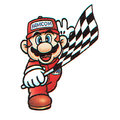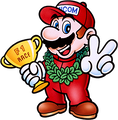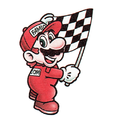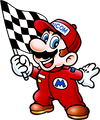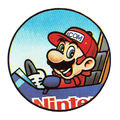Famicom Grand Prix: F1 Race: Difference between revisions
m (→Gallery) |
mNo edit summary |
||
| Line 15: | Line 15: | ||
'''''Famicom Grand Prix: F-1 Race''''' (ファミコングランプリ F1レース) is a Japan-exclusive racing game released for the [[Family Computer Disk System]] on October 30, 1987. It is a racing game starring [[Mario]] in Formula One cars. Japan held a Famicom Grand Prix: F-12 Contest, and players with the highest scores got a ''[[Super Mario Bros. (Game & Watch)|Super Mario Bros. Game & Watch]]'' sealed in a case shaped like Diskun, the mascot of the Disk System who appeared on all Disk System game covers (and also made an appearance as a [[trophy]] in ''[[Super Smash Bros. Melee]]''). A sequel was released, known as ''[[Famicom Grand Prix II: 3D Hot Rally]]'', and it was very different from ''F-1 Race''. | '''''Famicom Grand Prix: F-1 Race''''' (ファミコングランプリ F1レース) is a Japan-exclusive racing game released for the [[Family Computer Disk System]] on October 30, 1987. It is a racing game starring [[Mario]] in Formula One cars. Japan held a Famicom Grand Prix: F-12 Contest, and players with the highest scores got a ''[[Super Mario Bros. (Game & Watch)|Super Mario Bros. Game & Watch]]'' sealed in a case shaped like Diskun, the mascot of the Disk System who appeared on all Disk System game covers (and also made an appearance as a [[trophy]] in ''[[Super Smash Bros. Melee]]''). A sequel was released, known as ''[[Famicom Grand Prix II: 3D Hot Rally]]'', and it was very different from ''F-1 Race''. | ||
In the game, players can choose to play alone or with other cars. Cars have a certain amount of health and fuel, which decreases whenever the player crashes into a wall or another car, as well as whenever he or she drives off of the road. The player can go to a pit-stop to regenerate the health and fuel; however, doing this takes away race time. Winning the Grand Prix rewards players with [[ | In the game, players can choose to play alone or with other cars. Cars have a certain amount of health and fuel, which decreases whenever the player crashes into a wall or another car, as well as whenever he or she drives off of the road. The player can go to a pit-stop to regenerate the health and fuel; however, doing this takes away race time. Winning the Grand Prix rewards players with [[coin]]s (Money), which can be used to unlock hidden cars. | ||
This game was possibly an ancestor to the ''[[Mario Kart (series)|Mario Kart]]'' series, most likely due to the fact it features Mario and possesses a similar 2D racing mechanics, which was later carried on to ''[[Super Mario Kart]]''. | This game was possibly an ancestor to the ''[[Mario Kart (series)|Mario Kart]]'' series, most likely due to the fact it features Mario and possesses a similar 2D racing mechanics, which was later carried on to ''[[Super Mario Kart]]''. | ||
Revision as of 01:00, January 10, 2018
Famicom Grand Prix: F-1 Race (ファミコングランプリ F1レース) is a Japan-exclusive racing game released for the Family Computer Disk System on October 30, 1987. It is a racing game starring Mario in Formula One cars. Japan held a Famicom Grand Prix: F-12 Contest, and players with the highest scores got a Super Mario Bros. Game & Watch sealed in a case shaped like Diskun, the mascot of the Disk System who appeared on all Disk System game covers (and also made an appearance as a trophy in Super Smash Bros. Melee). A sequel was released, known as Famicom Grand Prix II: 3D Hot Rally, and it was very different from F-1 Race.
In the game, players can choose to play alone or with other cars. Cars have a certain amount of health and fuel, which decreases whenever the player crashes into a wall or another car, as well as whenever he or she drives off of the road. The player can go to a pit-stop to regenerate the health and fuel; however, doing this takes away race time. Winning the Grand Prix rewards players with coins (Money), which can be used to unlock hidden cars.
This game was possibly an ancestor to the Mario Kart series, most likely due to the fact it features Mario and possesses a similar 2D racing mechanics, which was later carried on to Super Mario Kart.


